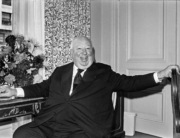The opening sequences of Framing John DeLorean abound with interviews in which many describe John DeLorean as an icon, a sex symbol, the perfect figure for a Hollywood film. It’s also mentioned that many films about DeLorean have been proposed over the years and that DeLorean’s story is so unbelievable that, were it not true, you wouldn’t dare imagine it.
I have to confess I spent the rest of the film wondering what on earth that statement meant. While it makes sense that, in his time, DeLorean was an icon and a sex symbol, his story is not unthinkable, especially by the standards of American films. How many have been made about men who rise to power and then rashly lose it all? It’s a familiar enough arc, and it’s the one that DeLorean followed and that this documentary emphasizes.
John DeLorean was an engineer and inventor who left General Motors to start his own company and invent the DeLorean, the car made immortal in Back to the Future, and his career toppled when he was caught on camera appearing to take part in a drug deal. This documentary is divided between interviews, footage from DeLorean’s time, and, intriguingly though not persuasively, reenactments, starring Alec Baldwin.
The film juggles its many elements and moves at a clipped pace, though it doesn’t do much to justify its existence. Perhaps that is too harsh. There are intriguing aspects to DeLorean’s story. He did not turn to drugs of his own volition but was lured into a sting operation by undercover FBI agents, who were aware that he was in dire straits financially with his company and might make a good target. The whole operation was a product of President Reagan’s war on drugs, and DeLorean won his case on the grounds that he had been unfairly targeted.
His company had its headquarters in Belfast, Northern Ireland, of all places, which I found genuinely surprising. I would have liked to hear more from the workers who found and lost jobs accordingly as the company crashed. Furthermore, the car itself was a marvel, though not as successful as its makers intended it to be. DeLorean had a brilliant marketing idea: to create a car that had all the chic of the classic sports car (Jaguar and Ferrari) but would be mass produced.
The film is at its most moving when his children are introduced, both of whom have struggled to process the experience of having and losing everything, and to come to terms with how they and the world viewed their father. His son, Zachary, takes us inside his apartment at one point, and it is a standard, cramped Brooklyn apartment, a far cry from the glorious house he grew up in. His sister, Kathryn, mentions the bullying she endured after her father’s scandal and says that joining the community of DeLorean lovers—those who still drive and worship her father’s famous car—helped her come to terms with her father.
Still, when the credits roll, it is unclear what exactly was so unique about this story that it merited a revisiting. DeLorean emerges as a much more predictable subject than the makers of this film intended. Great men who lose it all are a tired subject in both narrative and documentary filmmaking, which might be why none of those proposed feature films on DeLorean were ever made. Clearly there is a subgroup of people who still drive the car, and perhaps there are others who share the enthusiasm of all the interviewees for this man. Also, the film could be compelling for anyone who has ever run a business, for there is much talk of all of DeLorean’s tactical decisions. Yet I suspect for many of us, Framing John DeLorean will leave us simply with one question: Why?
Framing John DeLorean opens on June 7.







Leave A Comment